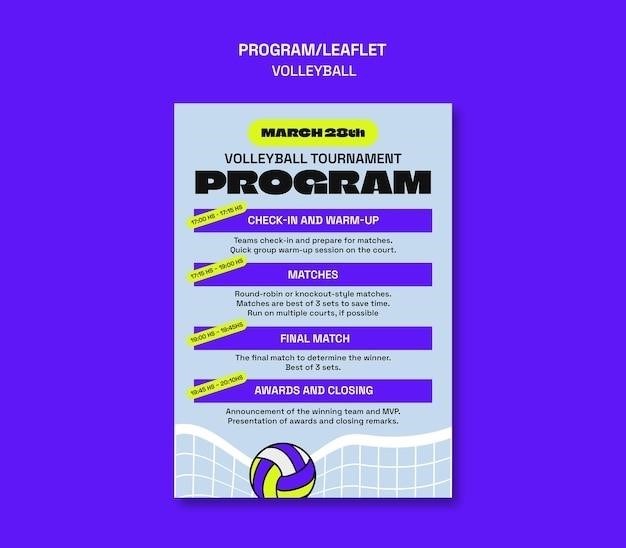12-Week Speed and Agility Program⁚ A Comprehensive Guide
This comprehensive guide outlines a 12-week program designed to enhance your speed and agility, crucial elements for athletic performance across various sports. We’ll explore the benefits, the science behind these skills, and provide a structured program incorporating strength training, speed drills, and agility drills. This program will equip you with the tools and knowledge to unlock your athletic potential and achieve peak performance.
Introduction
In the realm of athletics, speed and agility are paramount to success. Whether you’re a seasoned athlete or just starting your fitness journey, mastering these fundamental skills can significantly elevate your performance. This 12-week program is meticulously crafted to provide a comprehensive guide to developing both speed and agility, equipping you with the tools and knowledge to unlock your athletic potential. This program is not just about running faster; it’s about cultivating a dynamic blend of strength, power, and coordination that will translate into noticeable improvements across various sports and activities.
This program is designed to be a roadmap for your journey to enhanced athleticism. We’ll delve into the science behind speed and agility, exploring the key components of each and how they intertwine. You’ll learn the importance of building a solid foundation through strength and power training, essential for maximizing your speed and agility gains. We’ll then dive into a variety of speed drills, designed to refine your sprinting mechanics and increase your stride length and frequency. Agility drills, on the other hand, will challenge your ability to change direction quickly and efficiently, improving your responsiveness on the field. Finally, we’ll present a sample 12-week program that integrates all these elements, providing a clear framework for your training journey.
This guide emphasizes the importance of progression and adaptation. We understand that individuals progress at different rates. Therefore, we encourage you to listen to your body, adjust the program as needed, and focus on consistent effort and improvement. The ultimate goal is to create a personalized training plan that aligns with your individual needs and goals. Embark on this journey with us and unlock your true athletic potential.
Benefits of Speed and Agility Training
Investing in speed and agility training offers a multitude of benefits that extend far beyond improved athletic performance. These benefits can empower you on and off the field, impacting your overall fitness, health, and well-being. Here’s a glimpse into the transformative power of speed and agility training⁚
Firstly, enhanced athletic performance is the most tangible benefit. Increased speed translates to quicker reactions, faster sprints, and a greater ability to outrun opponents. Improved agility allows you to change direction with ease, making you more unpredictable and elusive. These combined advantages can give you a significant edge in any sport requiring quick movements, dynamic changes in direction, and explosive bursts of speed. Imagine sprinting past defenders with ease or reacting to a sudden change in play with incredible agility ౼ speed and agility training can make these scenarios a reality.
Beyond sports, speed and agility training can significantly improve your overall fitness. These workouts demand a high level of cardiovascular fitness, strengthening your heart and lungs. They also engage multiple muscle groups, promoting muscle growth and strength. The dynamic nature of these drills improves your coordination, balance, and stability, making you more agile and responsive in everyday life. The increased power and explosiveness you develop can translate into more efficient movements in daily activities, making tasks like climbing stairs or carrying groceries feel effortless.
Moreover, speed and agility training can have a profound impact on your mental acuity. These workouts challenge your cognitive function, improving your reaction time and decision-making abilities. The constant need to adapt and react builds mental toughness and resilience, enhancing your ability to handle pressure situations effectively. Ultimately, speed and agility training isn’t just about physical prowess; it’s about cultivating a well-rounded athlete, both physically and mentally.
Understanding Speed and Agility
To embark on a successful speed and agility training journey, it’s crucial to grasp the fundamental principles behind these athletic qualities. Speed and agility, while often intertwined, are distinct yet complementary skills that contribute significantly to overall athletic performance. Understanding their nuances allows for a more targeted and effective training approach.
Speed, in its simplest form, is the ability to move quickly over a given distance. It involves a complex interplay of factors, including stride length, stride frequency, and the efficiency of your biomechanics. Developing speed requires maximizing these factors, focusing on explosive power generation, proper form, and efficient energy utilization; Think of it as a symphony of coordinated movements, where each step propels you forward with maximum efficiency.
Agility, on the other hand, is the ability to change direction rapidly and efficiently without losing speed or balance. It involves a combination of speed, coordination, balance, and quick reaction time. Agility training emphasizes developing the ability to react to stimuli swiftly, anticipate movements, and execute complex maneuvers with precision. Imagine navigating a crowded field, reacting to a defender’s move, and seamlessly shifting direction to create space ౼ these are the hallmarks of agility.
While speed and agility training often go hand-in-hand, their distinct focuses require tailored approaches. Speed drills focus on maximizing linear movement, while agility drills emphasize multi-directional movements and quick changes in direction. Understanding these distinctions allows for a balanced training program that addresses both aspects, ultimately leading to a more complete and well-rounded athlete.
Speed Training
Speed training is a cornerstone of athletic development, aiming to maximize your ability to move quickly over a given distance. It’s not just about running fast; it’s about optimizing your stride length, stride frequency, and overall biomechanics to achieve peak velocity. This involves a combination of strength training, plyometrics, and specific speed drills that target the key components of speed development.
One crucial aspect of speed training is developing explosive power in your lower body, particularly your glutes, hamstrings, and quads. Strength training exercises like squats, deadlifts, and lunges help build the foundation for powerful strides. Plyometrics, which involve explosive jumps and landings, further enhance your power output and improve your ability to generate force quickly. Think of these exercises as “teaching” your muscles to react explosively, crucial for propelling yourself forward with maximum speed.

Once you’ve built a strong foundation, it’s time to incorporate specific speed drills. These drills focus on refining your technique, increasing your stride length, and improving your stride frequency. Examples include sprint starts, acceleration drills, and interval training. These drills not only enhance your physical capabilities but also help you develop proper form and efficient movement patterns, maximizing your speed potential.
Remember, speed training is a progressive process. Start with basic drills and gradually increase the intensity and complexity as your strength and speed improve. Listen to your body, rest adequately, and allow for proper recovery to avoid injury. With consistent dedication and proper training, you’ll see significant gains in your speed and overall athletic performance.
Agility Training
Agility training goes beyond simply moving fast; it’s about mastering the ability to change direction quickly and efficiently without sacrificing speed or control. It’s a crucial skill in many sports, enabling athletes to react swiftly to changing situations, outmaneuver opponents, and make decisive movements. Agility training involves a combination of drills that challenge your coordination, balance, and reaction time, helping you develop the ability to move seamlessly and explosively in any direction.
One key element of agility training is developing strong core muscles. A strong core provides stability and control, enabling you to shift your weight quickly and maintain balance while changing direction. Exercises like planks, side planks, and anti-rotation presses target your core muscles, enhancing your ability to maintain stability and control while moving dynamically. Another important aspect is improving your footwork. Drills like ladder drills, cone drills, and shuffle drills enhance your foot speed, coordination, and ability to change direction quickly and efficiently. These drills challenge your ability to react quickly, shift your weight smoothly, and maintain balance while navigating through various patterns and obstacles.
Agility training also involves developing your reaction time. Drills that involve reacting to visual cues, such as dodging cones or reacting to a coach’s commands, challenge your ability to process information quickly and respond accordingly. These drills improve your anticipation and ability to respond swiftly to changing situations, crucial for success in fast-paced sports. Remember that agility training is a skill that requires consistent practice and refinement. Start with basic drills and gradually increase the complexity and intensity as your agility improves. Focus on proper technique, maintain a controlled pace, and listen to your body to avoid injury. With consistent effort and proper training, you’ll see significant improvements in your agility, helping you outmaneuver opponents, react swiftly to changing situations, and perform at your peak.
Building the Foundation⁚ Strength and Power
Before diving into speed and agility drills, it’s crucial to establish a solid foundation of strength and power. These are the cornerstones of athletic performance, providing the raw power and explosiveness needed to move quickly and change direction efficiently. A well-designed strength and power training program will not only improve your speed and agility but also reduce your risk of injuries. Focus on compound exercises that work multiple muscle groups simultaneously, such as squats, deadlifts, lunges, and presses. These exercises engage your major muscle groups, building overall strength and power, which directly translates to improved speed and agility.
Squats, for example, target your quads, hamstrings, glutes, and calves, building lower body strength crucial for explosive movements and powerful starts. Deadlifts engage your entire posterior chain, including your back, glutes, and hamstrings, enhancing your ability to generate power and maintain stability. Lunges challenge your balance and coordination, strengthening your leg muscles and improving your agility. Presses, such as bench press and overhead press, build upper body strength, essential for pushing off the ground powerfully and maintaining stability during dynamic movements. Incorporate plyometric exercises into your routine to further enhance your explosiveness and power. Plyometrics involve jumping, bounding, and hopping, engaging your muscles in a rapid, explosive manner, improving your ability to generate power quickly and efficiently.
Examples of plyometric exercises include box jumps, jump squats, and depth jumps. Remember to prioritize proper form and technique throughout your strength and power training. Start with lighter weights and gradually increase the weight as you get stronger. Focus on controlled movements, maintaining proper form, and listening to your body to avoid injury. By building a strong foundation of strength and power, you’ll set yourself up for success in your speed and agility training, unlocking your full athletic potential and achieving peak performance.
Speed Drills
Speed drills are the heart of a comprehensive speed and agility program, designed to improve your stride length, stride frequency, and overall running mechanics. These drills focus on developing the specific skills and techniques required for fast, efficient movement. A well-structured speed drill program should incorporate a variety of drills that target different aspects of sprinting, such as acceleration, top-end speed, and recovery. Start with simple drills like high knees and butt kicks to warm up your muscles and prepare your body for more intense work.
Once warmed up, progress to drills that focus on proper sprinting technique, like the “A” skip and the “hammer” drill. The “A” skip emphasizes proper leg drive and hip extension, crucial for generating power and maximizing stride length. The “hammer” drill focuses on maintaining proper arm swing and posture, essential for maintaining balance and momentum during sprinting. As you progress, incorporate drills that challenge your acceleration and top-end speed, such as flying 10s and 20s. Flying 10s and 20s involve sprinting short distances at full speed, developing your ability to accelerate quickly and reach top speed efficiently.
Remember to focus on proper form and technique throughout your speed drills. Maintain a tall, upright posture, drive your knees high, and swing your arms in a powerful, rhythmic motion. Listen to your body, and gradually increase the intensity and distance of your drills as you improve. By consistently practicing these drills, you’ll develop the speed and efficiency you need to dominate on the field or court. Remember to include a proper warm-up and cool-down before and after each session to prevent injuries and promote recovery.
Agility Drills
Agility drills are essential for developing the ability to change direction quickly and efficiently without losing speed or balance. These drills simulate game-like situations, requiring athletes to react swiftly and move with precision. A well-designed agility program should incorporate a variety of drills targeting different movement patterns, including lateral shuffles, cone drills, and plyometric exercises. Start with simple drills like side-to-side line hops and lateral skips to build a solid foundation for more complex movements.
Once comfortable with the basics, progress to drills like the cone drill and the “T” drill. The cone drill challenges your ability to navigate around obstacles, improving your footwork and coordination. The “T” drill focuses on explosive starts and quick turns, essential for changing direction and pursuing opponents effectively. Incorporate plyometric exercises like lateral box jumps and depth jumps to enhance your explosiveness and power, crucial for generating the force needed for quick, decisive movements.
Remember to focus on proper technique and controlled movement throughout your agility drills. Land softly on the balls of your feet, maintain a low center of gravity, and keep your eyes focused on your target. Gradually increase the intensity and complexity of the drills as you improve, challenging yourself to react faster and move more efficiently. By consistently practicing agility drills, you’ll develop the quickness, agility, and coordination needed to outmaneuver your opponents and excel in any sport.
Sample 12-Week Program
This sample 12-week program provides a structured framework for developing speed and agility. It incorporates strength training, speed drills, and agility drills, progressively increasing the intensity and complexity over time. This program is designed to be a guideline, and it’s important to adapt it to your individual needs and training goals. Consult with a qualified coach or trainer for personalized guidance and modifications.
The program is divided into three phases, each lasting four weeks. Phase 1 focuses on building a solid foundation by establishing proper form and technique. Phase 2 increases the intensity and volume of training, challenging your body to adapt and improve. Phase 3 emphasizes refinement and application, integrating your skills into more complex drills and game-like scenarios. Each phase includes specific exercises and drills tailored to enhance speed and agility. Remember to listen to your body, prioritize proper recovery, and gradually progress through the program.
This sample program provides a roadmap for your journey towards peak performance. By consistently following the program, incorporating proper nutrition and rest, and staying committed to your goals, you’ll unlock your athletic potential and achieve significant improvements in your speed and agility.




Be the first to reply